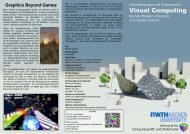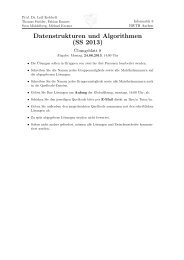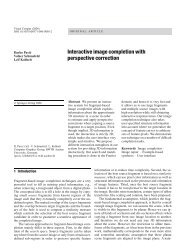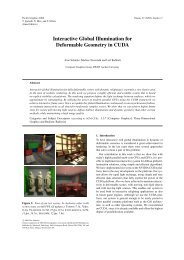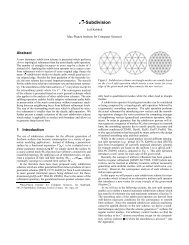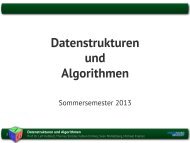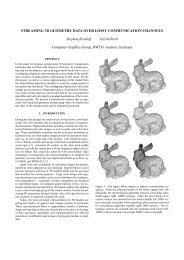Structure Preserving CAD Model Repair - OpenFlipper
Structure Preserving CAD Model Repair - OpenFlipper
Structure Preserving CAD Model Repair - OpenFlipper
Create successful ePaper yourself
Turn your PDF publications into a flip-book with our unique Google optimized e-Paper software.
Stephan Bischoff & Leif Kobbelt / <strong>Structure</strong> <strong>Preserving</strong> <strong>CAD</strong> <strong>Model</strong> <strong>Repair</strong><br />
octree nodes have integer coordinates, i.e. they correspond<br />
to grid vertices. If n is an octree node, we denote by c n ∈ Z 3<br />
its center and by 0 ≤ d n ≤ k its depth. Hence, if n is a finestlevel<br />
node (d n = k) we want to check whether<br />
Box(n) := Box γ(c n)<br />
is intersected by two or more different patches. Our idea is to<br />
build up a hierarchy of nested boxes which matches the octree<br />
hierarchy. Hence, if n is an interior octree node, Box(n)<br />
is chosen such that it contains the boxes of all descendants<br />
of n. A short calculation shows that this property is fulfilled<br />
by letting<br />
Box(n) := Box hn (c n),<br />
h n = 2 k−dn−1 − 1/2 + γ<br />
Note in particular, that a triangle intersecting the box of a<br />
finest-level node n will also intersect the boxes of all ancestors<br />
of n. We now recursively insert each triangle of M into<br />
the octree using an algorithm similar to that of Ju [Ju04].<br />
Starting with the root node, a triangle is inserted into a node<br />
n if it intersects Box(n). This can efficiently be tested using<br />
the separating axes theorem [GLM96]. If a node n contains<br />
triangles belonging to different patches, n is split and the triangles<br />
are distributed to its children. In the end, the center<br />
c n ∈ Z 3 of each finest-level node n that contains triangles<br />
belonging to two or more patches represents an ambiguous<br />
vertex.<br />
To increase the resolution of the critical region near M,<br />
we also compute the directed distances of each critical vertex<br />
v ∈ C γ to M by shooting rays along the coordinate axes (Figure<br />
3). Fortunately, the temporary octree we built up above<br />
already provides a spatial search structure to speed up the<br />
ray-model intersection tests. If we find an intersection within<br />
unit distance, we denote the triple (v,d,δ) consisting of the<br />
vertex v, the direction<br />
d ∈ ±{(1,0,0) T ,(0,1,0) T ,(0,0,1) T }<br />
and the distance δ ∈ [0,1] as a cut. The cuts will later be<br />
used for resampling the geometry at the points v + δd. In<br />
the figures, cuts are illustrated as small arrows attached to v<br />
and pointing in direction d, see Figure 3.<br />
3.3. Eroding C γ<br />
In the previous stage we computed a set C := C γ of critical<br />
vertices which we think of as particles that fill in all gaps of<br />
M. Later stages of the algorithm will extract the boundary<br />
of C to create surface patches that actually close these gaps<br />
and resolve the intersections. As this fill-in should alter M<br />
as little as possible, C should be as small as possible. Hence<br />
we replace C by a minimal set C ′ ⊂ C that still fills in all<br />
gaps. We get C ′ by applying a topology-preserving erosion<br />
operator on C, i.e. we successively remove critical vertices<br />
from C that are simple. (Note that we only remove critical<br />
vertices but not the cuts.) Intuitively, a vertex is called simple,<br />
if its removal does not change the topology of C, i.e. if it<br />
patch ambiguous vertex<br />
cuts critical vertex ∈ C 1<br />
Figure 3: Example configurations. Some possible configurations<br />
of patches Q ∈ M are shown above. Note that each<br />
patch is a closed triangle mesh. The critical vertices C γ fill<br />
the regions where two or more different patches of M are<br />
less than 2γ away from each other. Cuts effectively provide<br />
sub-voxel accuracy near M.<br />
does not create new connected components or handles. The<br />
exact definition of simplicity and an efficient method to determine<br />
whether a vertex is simple from its 26-neighborhood<br />
is given in [BK03]. However, we have to take into account,<br />
that in our case the cuts represent material, while in [BK03]<br />
the cuts represent empty space.<br />
We proceed as follows: For each critical vertex v, we compute<br />
its distance d(v) to the boundary of C γ. If v has a noncritical<br />
neighbor, we set d(v) = 0. The distances of the other<br />
critical vertices are computed by a distance transform on C γ<br />
that respects the cuts, i.e. distances are not propagated over<br />
a cut. We then remove ⌈2γ⌉ layers of simple critical vertices<br />
to get a new set C ′ of critical vertices (Figures 4(left) and 5):<br />
for layer=0,1,...,⌈2γ⌉ do<br />
for all vertices v with d(v)=layer do<br />
if v is simple then<br />
set v to non-critical<br />
As the following reconstruction will take place along the<br />
cuts, there should be cuts between non-critical vertices w ∉<br />
C ′ and critical vertices v ∈ C ′ . Furthermore, there should be<br />
no cuts between vertices v ∈ C ′ and M (Figures 4(right)<br />
and 5). Hence, if v is a critical vertex, we remove all cuts<br />
(v,d,δ) and instead insert cuts (w,v − w,δ smooth ) for all<br />
c○ The Eurographics Association and Blackwell Publishing 2005.




